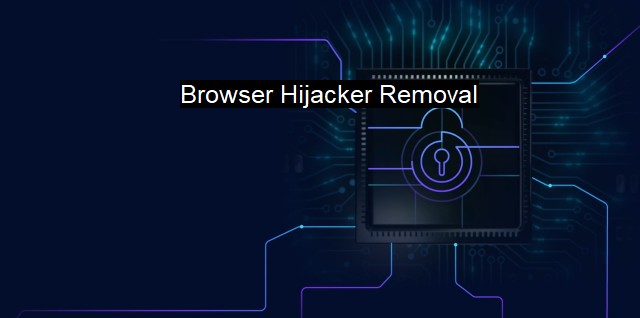What is Browser Hijacker Removal?
Understanding Browser Hijacker Malware: Impact, Nature and Removal Methods
A "Browser Hijacker" represents one of the notable malicious programs, categorized under Potentially Unwanted Programs (PUP). It generally aims to modify the settings of a web browser without explicit consent from the user, redirecting the landing page to unauthorized websites, showing unrequested advertisements, either classified as phishing emails to the user or changing the default search engine in the browser. Cybersecurity is a practice that can protect systems, networks, and programs from such potential digital threats, predominantly given current digitalization, with an emphasis on dealing with Browser Hijacker Removal before posing severe threats.The comprehensive approach that one adopts to eliminate these browser hijackers, document Browser Hijacker Removal. Understanding the nature of browser hijacking, one could view Browser Hijacker Removal similar to any antivirus software, emphasizing specific means of attack wherein the affected individual's userid, password, personal or customer data, even particular corporate strategies get either altered or crashed.
The subtlety behind Browser Hijacker Removal lies in its versatility. With the rise in concealment tactics, hijackers often camouflage their actions behind legitimate operations. Wary of such methodologies, Browser Hijacker Removal takes combative actions that detect, disrupt and eradicate browser hijackers, thereby safeguarding uers' browsing experiences.
A browser hijacker can stealthily enter into a program protocol using multiple channels. Of common ways, the most prevalent one is voluntary download posing as a mandatory system upgrade or software designed to enhance browser performance. In other instances, they sneak in through pop-up advertisements, email attachments, external storage devices, etc., making it apparent that unsuspecting users expose themselves to potential threats. Therefore, the initial step towards Browser Hijacker Removal begins with practices of due diligence. This step includes being mindful of the content accessed, downloaded and having a robust spam detection system.
Building upon damage dealing, the next step would involve in-depth scanning mechanisms. A spent website with embedded virus strains in parsing its data banks for liberation can illustrate a method of counterattack. Running diagnostic tools put algorithm-based sorting to use which (after carefully organizing infecting files either according to characteristics, dependencies, or their nature of the origin point), eradicates suspected browser-hijacking elements.
Another nifty tactic employed by cybersecurity suites is 'system restore point', a stored snapshot allowing your computer to return to a healthier state of operation. In the digital equivalent of constructive surgery, any traces of these hijackers are sought out and neutralized.
Despite other methods of fending off hijackers exist, 'inoculating' antivirus programs remains on top with consistent updates. Revisions help the software stay attuned to combating emerging threats in an evolving digital landscape. Thereon, reinforcing a data network with additional firewall applications manages illicit entries into an authorized database - burdening hijackers in acquiring ample space to wreak havoc.
Given the complexity of cybersecurity threats, programs facilitating Browser Hijacker Removal need to pass the dynamic hood to determine their effectiveness, keeping in respect not merely potential danger but catalyzing rapid removal countermeasures.
While Browser Hijacker Removal remains the first line of defense against unauthorized control over internet browsers, its cultivation rests upon tackling general Internet negligence. Browser Hijacker Removal, thus, necessitates providing everyone a safe and smooth browsing experience. Viewing its implication onto a broader perspective automatically maneuvers websites' interaction property in aid of clicking suspect adverts and entering insecure web areas besides hijacking user interface changes.
Although engaging in activities regarding personal data offloading requires a measured response, enhancing cybersecurity habits brings Browser Hijacker Removal just another method of varnishing user interaction - ensuring hijackers balk at accessible routes to tranny practices, pushing our digitally reliant world and antivirus protocols towards expansive, secure horizons.

Browser Hijacker Removal FAQs
What is a browser hijacker?
A browser hijacker is a type of malware that takes control of your web browser and changes your homepage, search engine, and other settings without your consent. It can also redirect you to malicious websites and display unwanted pop-up ads.How can I tell if my browser is infected with a hijacker?
Some common signs of a browser hijacker include frequent pop-up ads, a homepage or search engine that you did not set, a new toolbar or extension that you did not install, and unexpected website redirects. If you notice any of these symptoms, you may have a browser hijacker infection.How can I remove a browser hijacker from my computer?
To remove a browser hijacker, you should first run a full scan of your system using a reputable antivirus program. Once the scan is complete, you can use the antivirus software to remove any detected threats. You may also need to manually reset your browser settings to remove any unwanted changes.How can I prevent browser hijackers from infecting my computer?
To prevent browser hijackers, you should always be careful when downloading and installing software from the internet. Only download from reputable sources and read all installation prompts carefully. You should also keep your antivirus software up to date and avoid clicking on suspicious links or pop-up ads.| | A | | | B | | | C | | | D | | | E | | | F | | | G | | | H | | | I | | | J | | | K | | | L | | | M | |
| | N | | | O | | | P | | | Q | | | R | | | S | | | T | | | U | | | V | | | W | | | X | | | Y | | | Z | |
| | 1 | | | 2 | | | 3 | | | 4 | | | 7 | | | 8 | | |||||||